Effect of Girder Spacing and Depth on the Solitary Wave Impact on Coastal Bridge Deck for Different Airgaps
Abstract
:1. Introduction
2. Numerical Modeling and Validation
2.1. Numerical Model
2.2. Model Domain and Mesh Sensitivity Study
2.3. Validation of Numerical Model
3. Solitary Wave Impact on Deck
3.1. Effect of Girders Under the Deck
3.2. Effect of Wave Height
3.3. Effect of Girder Spacing and Thickness
3.4. Effect of Railing and Overhang
4. Conclusions
- The vertical impact force on a flat deck and a deck with girders are observed to be the same under submerged conditions while for elevated cases, decks with girders have a higher impact force due to air entrapment inside chambers. As the airgap increases, there is a sudden increase of vertical impact force for the decks with girders due to air entrapment forces, which reduces with a further increase of the airgap.
- The peak vertical impact force increases with the increase in the H/d ratio and reduces afterwards for different airgaps. For larger wave heights, the vertical impact force is reduced at higher airgaps as the sudden impact occurs at the deck sides, increasing the horizontal impact force and reducing the force due to air entrapment.
- The reduction in girder spacing can cause large vertical impact forces on the deck for larger wave heights due to higher air entrapment. It is observed that for Sg/H greater than 2, the peak vertical impact force has less dependence on girder spacing for different airgaps considered and for Sg/H lower than 2, the peak vertical impact force increases drastically for higher airgaps. The PCA analysis carried out to investigate the inter-dependency of parameters shows large variability in the peak vertical impact force with reduced spacing and increased girder depth.
- The effect of the girder depth on the peak vertical impact force is not substantial. Thus, girders with larger spacing and depths can be adopted in order to reduce the vertical impact force.
- The provision of railing and overhang on the deck allows less water into the chamber between the girders and reduces the air entrapment.
- The maximum vertical impact force observed at higher airgaps can be reduced by providing railing and overhang on the deck.
Author Contributions
Funding
Conflicts of Interest
Abbreviation
| a | amplitude |
| Ah | Horizontal Projected area of flat deck |
| Av | Vertical Projected area of flat deck |
| B | width of the plate |
| d | water depth |
| dg | girder depth |
| Fh | Horizontal impact force per unit width |
| Fv | Vertical impact force per unit width |
| g | acceleration due to gravity |
| H | wave height |
| Lh | Overhang Length |
| Lp | Length of plate |
| P | Pressure |
| Rh | Railing height |
| S | airgap measured from SWL to the top of the deck |
| Sg | Spacing of girders |
| t | instantaneous time |
| tp | plate thickness |
| x | horizontal distance |
| ρ | Fluid density |
| η | Wave elevation |
| Δx | mesh size |
| Δt | time step |
References
- Pile, J.; Hansom, J.D.; Switzer, A.D. Extreme Waves: Causes, Characteristics and Impact on Coastal Environments and Society. In Coastal and Marine Hazards, Risks, and Disasters; Chapter 11; Elsevier: Amsterdam, The Netherlands, 2015; pp. 307–330. [Google Scholar]
- French, J.A. Wave Uplift Pressures on Horizontal Platforms. Ph.D. Thesis, California Institute of Technology, Pasadena, CA, USA, 1970. [Google Scholar]
- Suchithra, N.; Koola, P.M. A study of wave impact of horizontal slabs. Ocean Eng. 1995, 22, 687–697. [Google Scholar] [CrossRef]
- Kaplan, P. Wave impact forces on offshore structures: Re-Examination and New Interpetations. In Proceedings of the Offshore Technology Conference, Houston, TX, USA, 4–7 May 1992. [Google Scholar]
- Kaplan, P.; Murray, J.J.; Yu, W.C. Theoretical Analysis of Wave Impact Forces on Platform Deck Structures; American Society of Mechanical Engineers: New York, NY, USA, 1995. [Google Scholar]
- Ren, B.; Wang, Y. Experimental study of irregular wave impact on structures in the splash zone. Ocean Eng. 2003, 30, 2363–2377. [Google Scholar] [CrossRef]
- Tirindelli, M.; Cuomo, G.; Allsop, W.; McConnell, K. Exposed Jetties: Inconsistencies and Gaps in Design Methods for Wave-Induced Forces. Coast. Eng. Proc. 2003. [Google Scholar] [CrossRef]
- Tirindelli, M.; Cuomo, G.; Allsop, W.; Lamberti, A. Wave-in-Deck Forces on Jetties and Related Structures Wave-in-Deck Forces on Jetties and Related Structures. In Proceedings of the Thirteenth International Offshore and Polar Engineering Conference, Honolulu, HI, USA, 25–30 May 2003. [Google Scholar]
- Cuomo, G.; Allsop, W.; McConnell, K. Dynamic Wave Loads on Coastal Structures: Analysis of Impulsive and Pulsating Wave Loads. In Proceedings of the 2003 Coastal Structures American Society of Civil Engineers, Portland, OR, USA, 26–30 August 2003; pp. 356–368. [Google Scholar]
- Cuomo, G.; Tirindelli, M.; Allsop, W. Wave-in-deck loads on exposed jetties. Coast. Eng. 2007, 54, 657–679. [Google Scholar] [CrossRef]
- Cuomo, G.; Shimosako, K.; Takahashi, S. Wave-in-deck loads on coastal bridges and the role of air. Coast. Eng. 2009, 56, 793–809. [Google Scholar] [CrossRef]
- Lamberti, A.; Martinelli, L.; Gabriella Gaeta, M.; Tirindelli, M.; Alderson, J. Experimental spatial correlation of wave loads on front decks. J. Hydraul. Res. 2011, 49, 81–90. [Google Scholar] [CrossRef]
- Gaeta, M.G.; Martinelli, L.; Lamberti, A. Uplift Forces on Wave Exposed Jetties: Scale Comparison and Effect of Venting. Coast. Eng. 2012, 1, 34. [Google Scholar] [CrossRef]
- Gabriella, M.; Lamberti, A. The role of air modeling on the numerical investigation of coastal dynamics and wave-structure interactions. Comput. Fluids 2015, 111, 114–126. [Google Scholar] [CrossRef]
- Seiffert, B.; Hayatdavoodi, M.; Ertekin, R.C. Experiments and computations of solitary-wave forces on a coastal-bridge deck. Part I: Flat Plate. Coast. Eng. 2014, 88, 194–209. [Google Scholar] [CrossRef]
- Hayatdavoodi, M.; Seiffert, B.; Ertekin, R.C. Experiments and computations of solitary-wave forces on a coastal-bridge deck. Part II: Deck with girders. Coast. Eng. 2014, 88, 194–209. [Google Scholar] [CrossRef]
- Seiffert, B.R.; Ertekin, R.C.; Robertson, I.N. Wave loads on a coastal bridge deck and the role of entrapped air. Appl. Ocean Res. 2015, 53, 91–106. [Google Scholar] [CrossRef]
- Azadbakht, M.; Yim, S.C. Effect of trapped air on wave forces on coastal bridge superstructures. J. Ocean Eng. Mar. Energy 2016, 2, 139–158. [Google Scholar] [CrossRef]
- Xu, G.; Cai, C.; Deng, L. Numerical prediction of solitary wave forces on a typical coastal bridge deck with girders. Struct. Infrastruct. Eng. 2017, 13, 254–272. [Google Scholar] [CrossRef]
- Hayatdavoodi, M.; Ertekin, R.C. Review of Wave Loads on Coastal Bridge Decks. Appl. Mech. Rev. 2016, 68, 030802. [Google Scholar] [CrossRef]
- Bihs, H.; Kamath, A.; Chella, M.A.; Aggarwal, A.; Arntsen, Ø.A. A new level set numerical wave tank with improved density interpolation for complex wave hydrodynamics. Comput. Fluids 2016, 140, 191–208. [Google Scholar] [CrossRef]
- Bihs, H.; Kamath, A. A combined level set/ghost cell immersed boundary representation for floating body simulations. Int. J. Numer. Methods Fluids 2017, 83, 905–916. [Google Scholar] [CrossRef]
- Jiang, G.-S.; Shu, C.-W. Efficient Implementation of Weighted ENO Schemes. J. Comput. Phys. 1996, 228, 202–228. [Google Scholar] [CrossRef]
- Shu, C.-W. Total-Variation-Diminishing Time Discretizations. Siam J. Sci. Stat. Comput. 1988, 9, 1–8. [Google Scholar] [CrossRef]
- Courant, R.; Friedrichs, K.; Lewy, H. On the partial difference equations of mathematical physics. Ibm J. Res. Dev. 1967, 1, 215–234. [Google Scholar] [CrossRef]

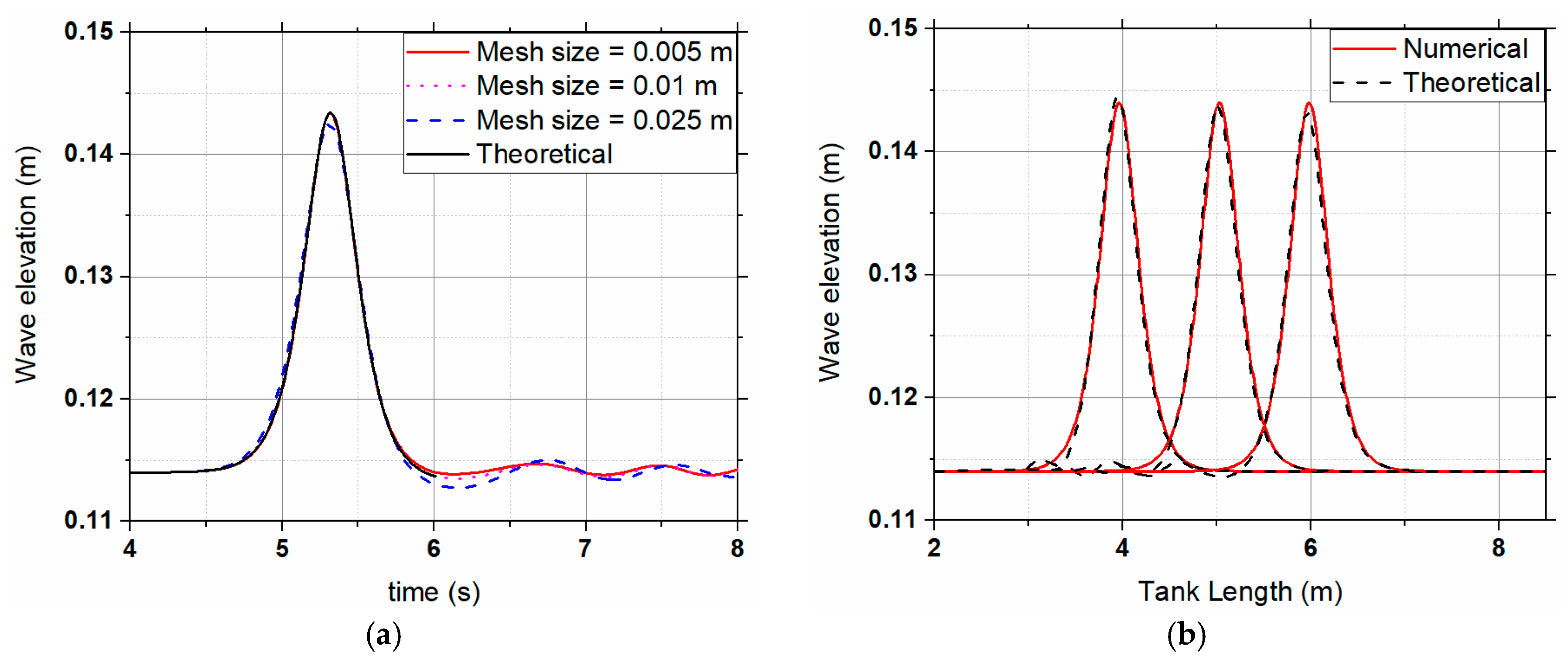
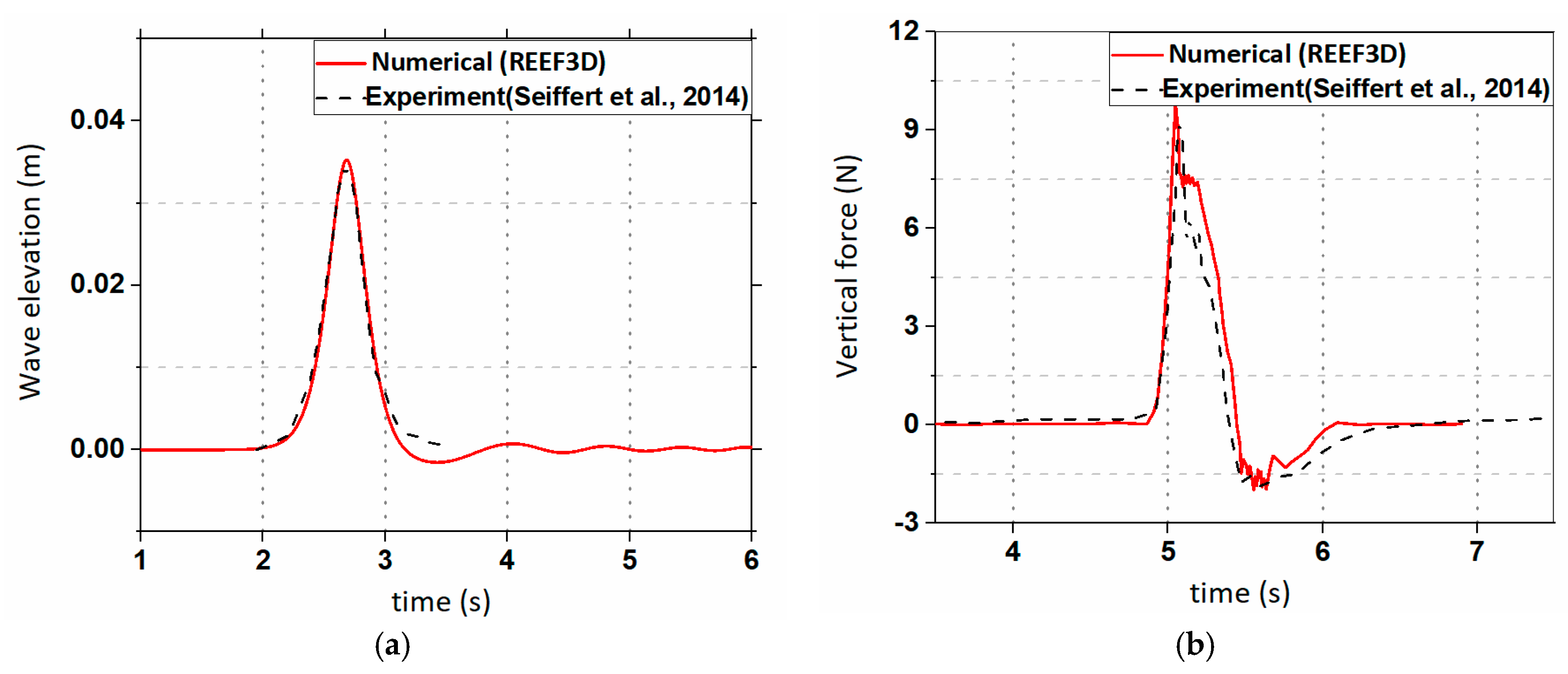


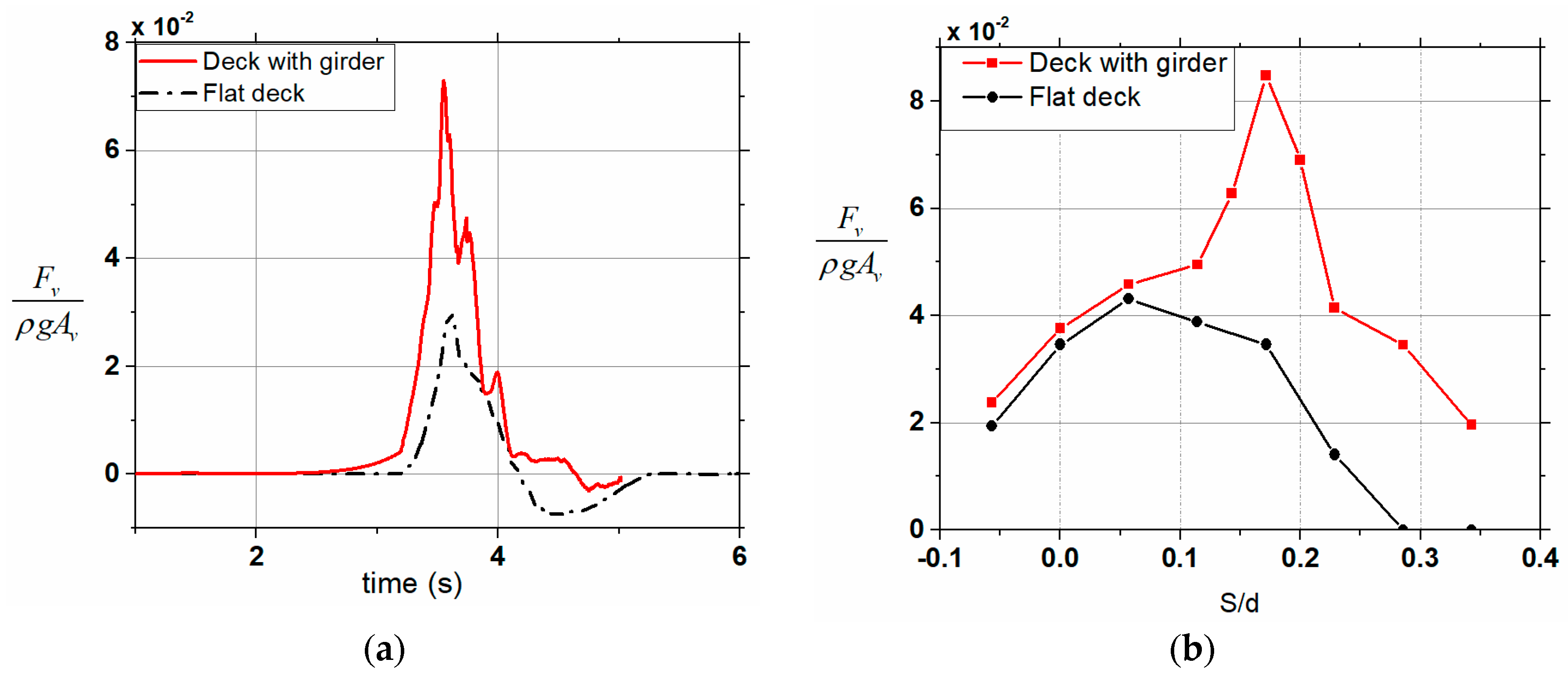
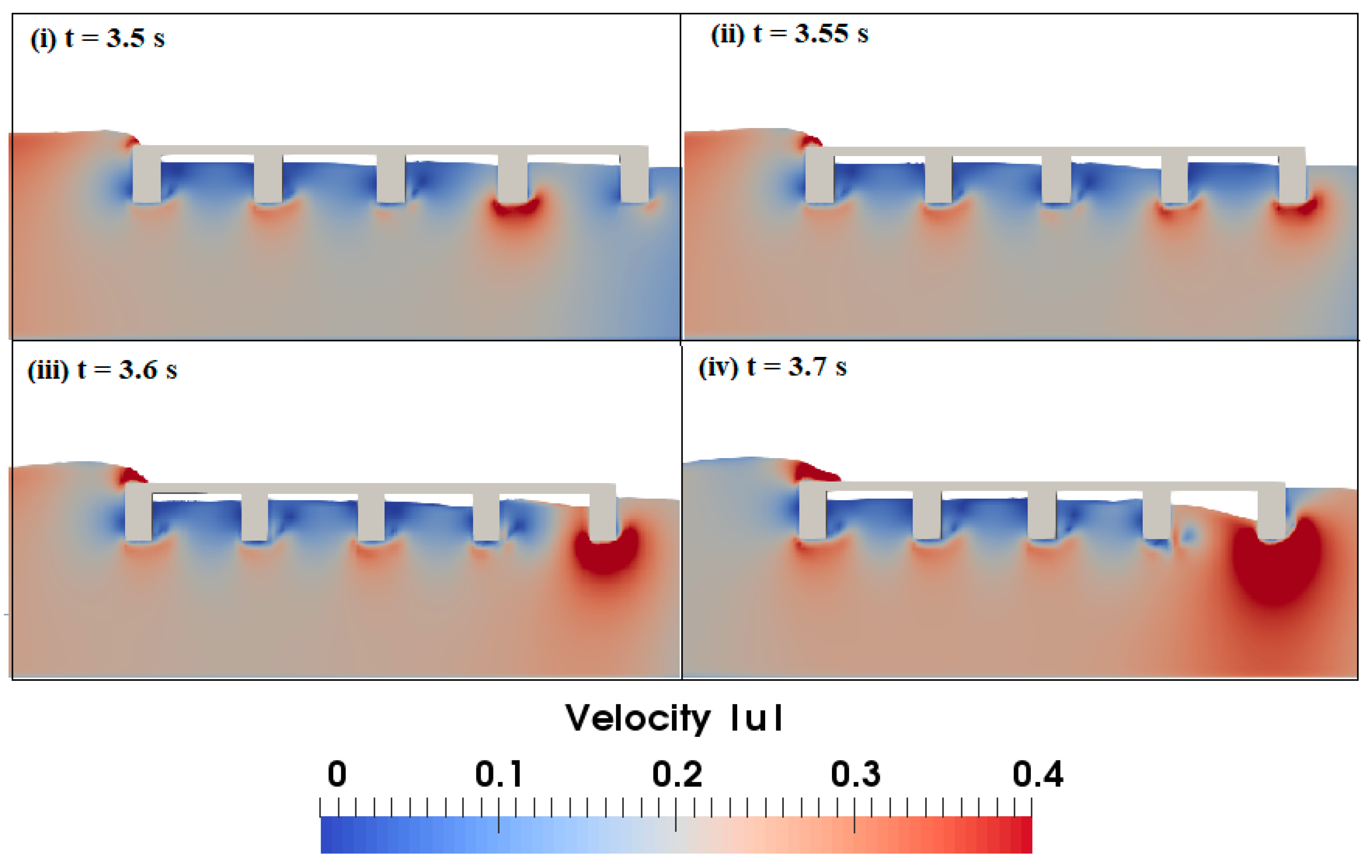
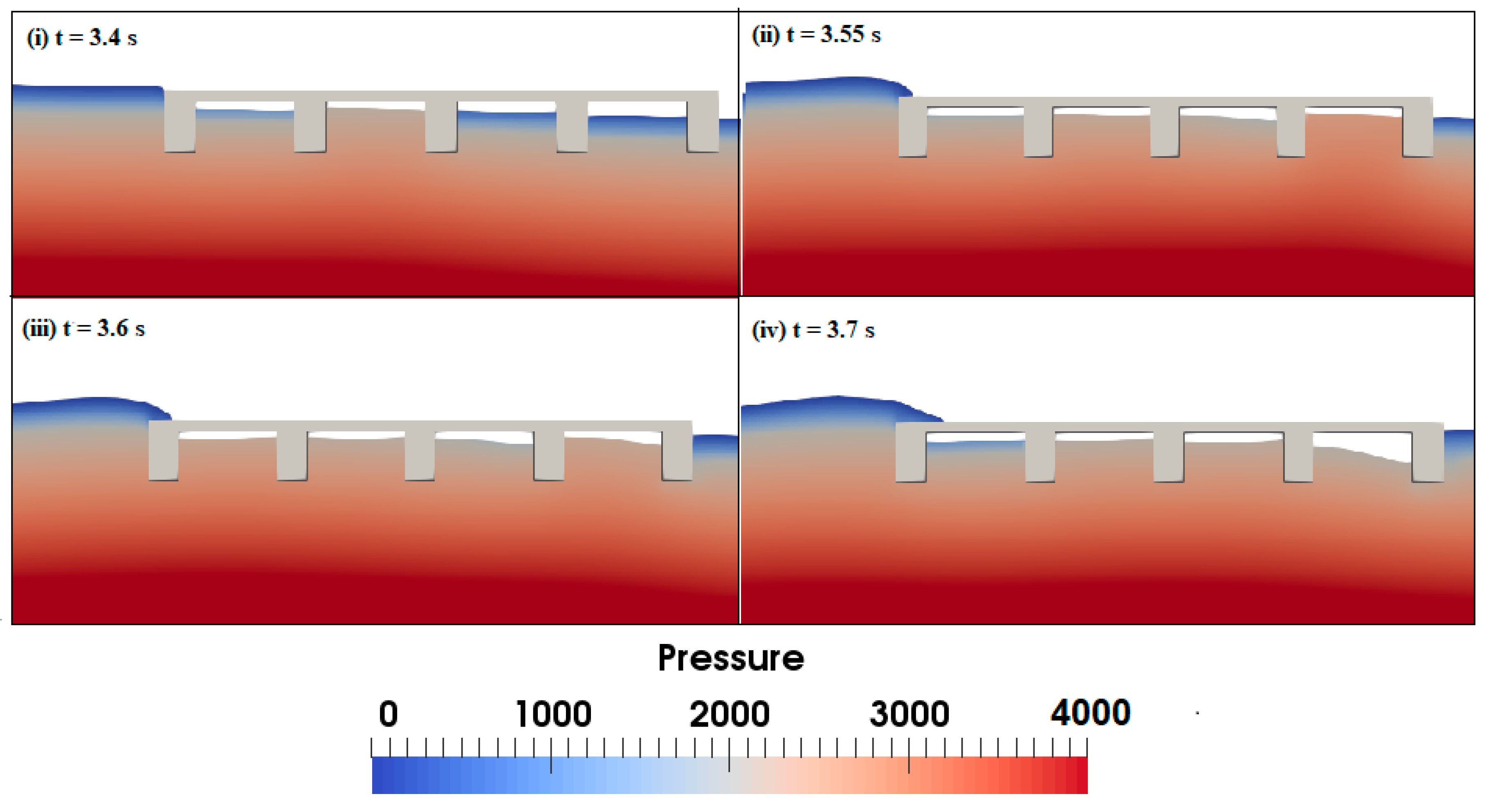
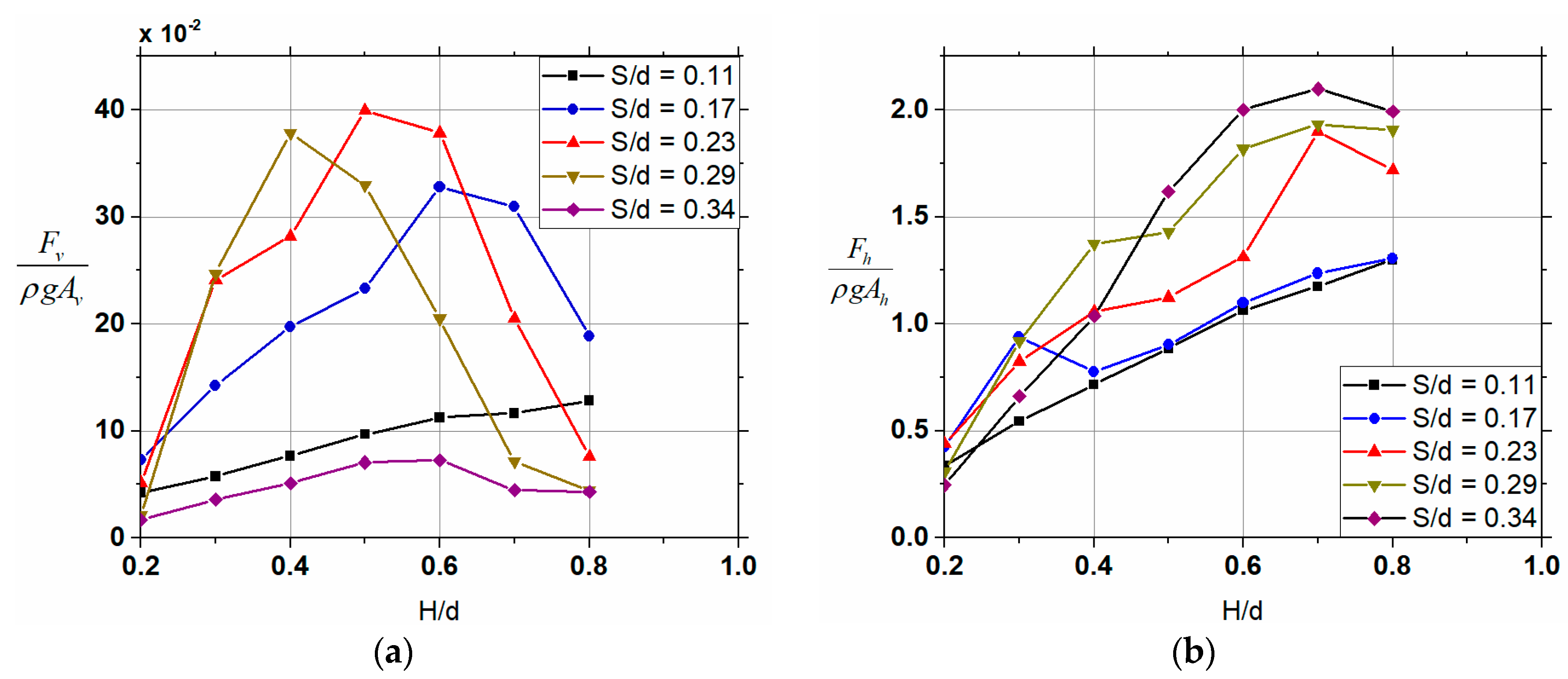
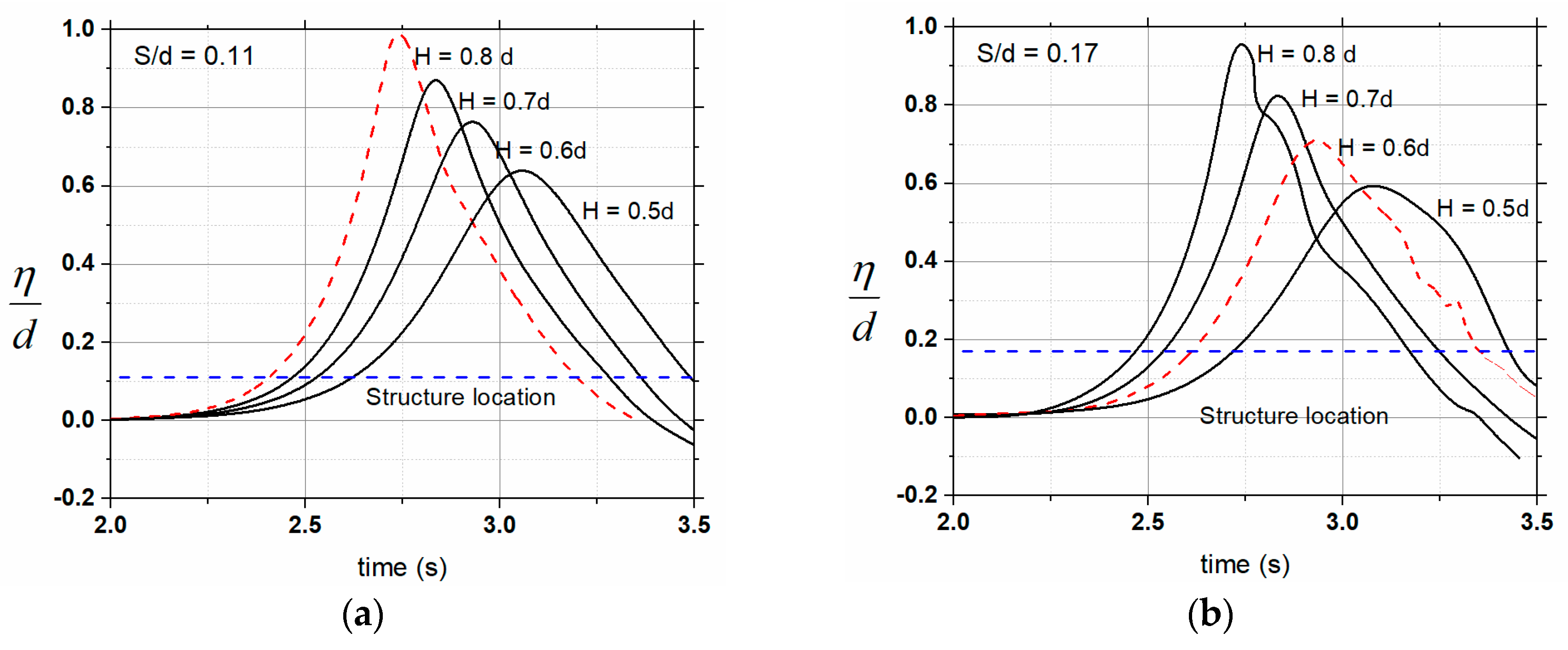
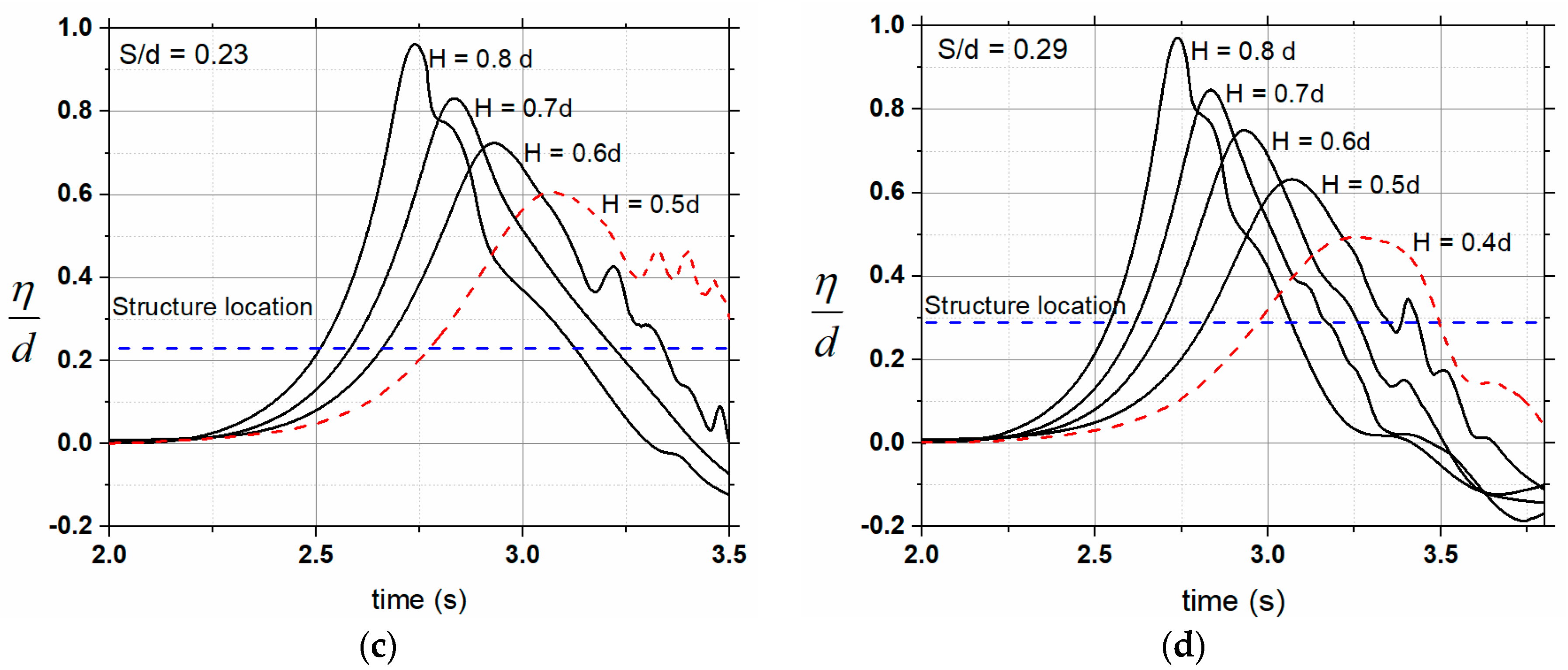
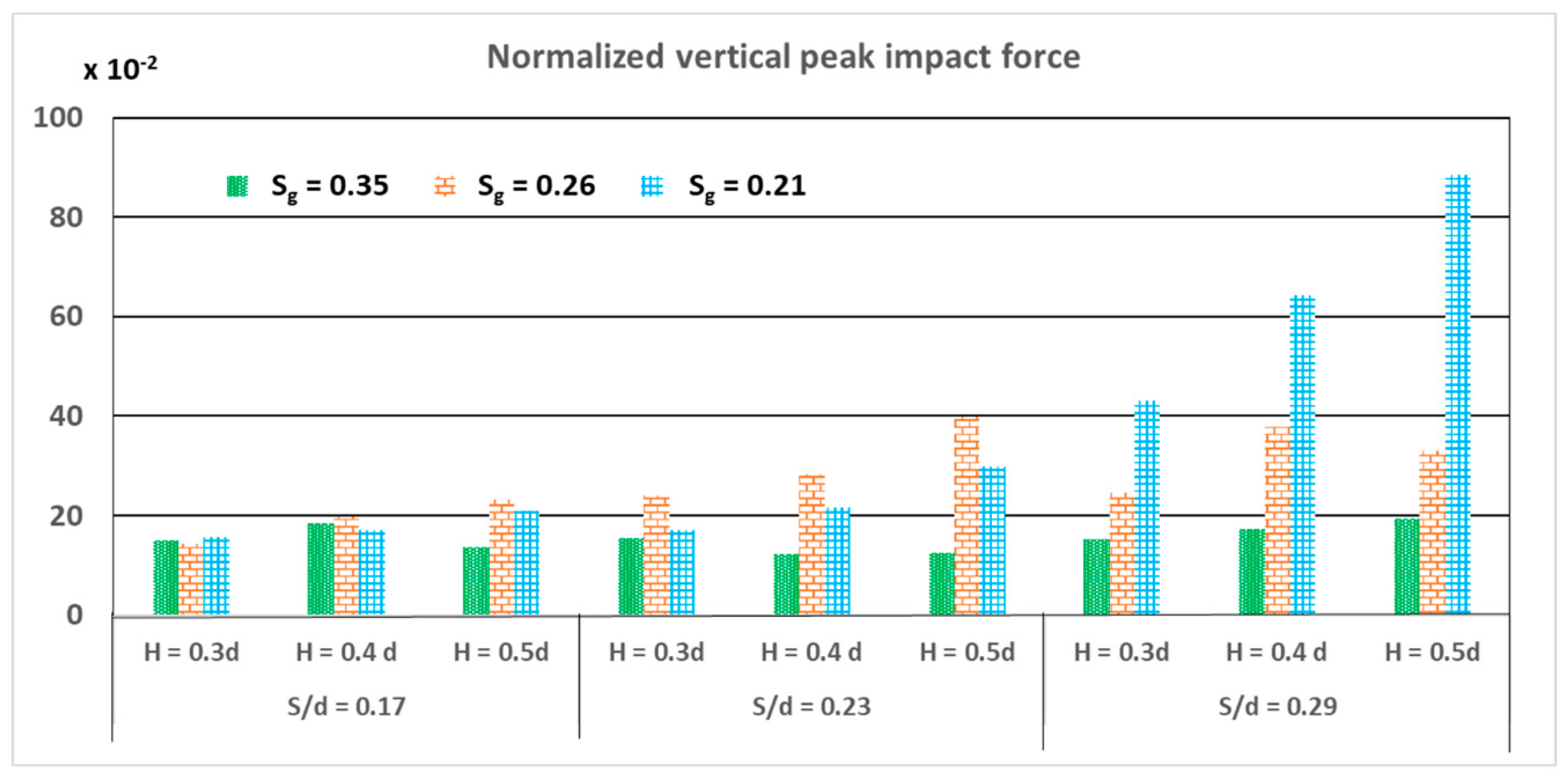
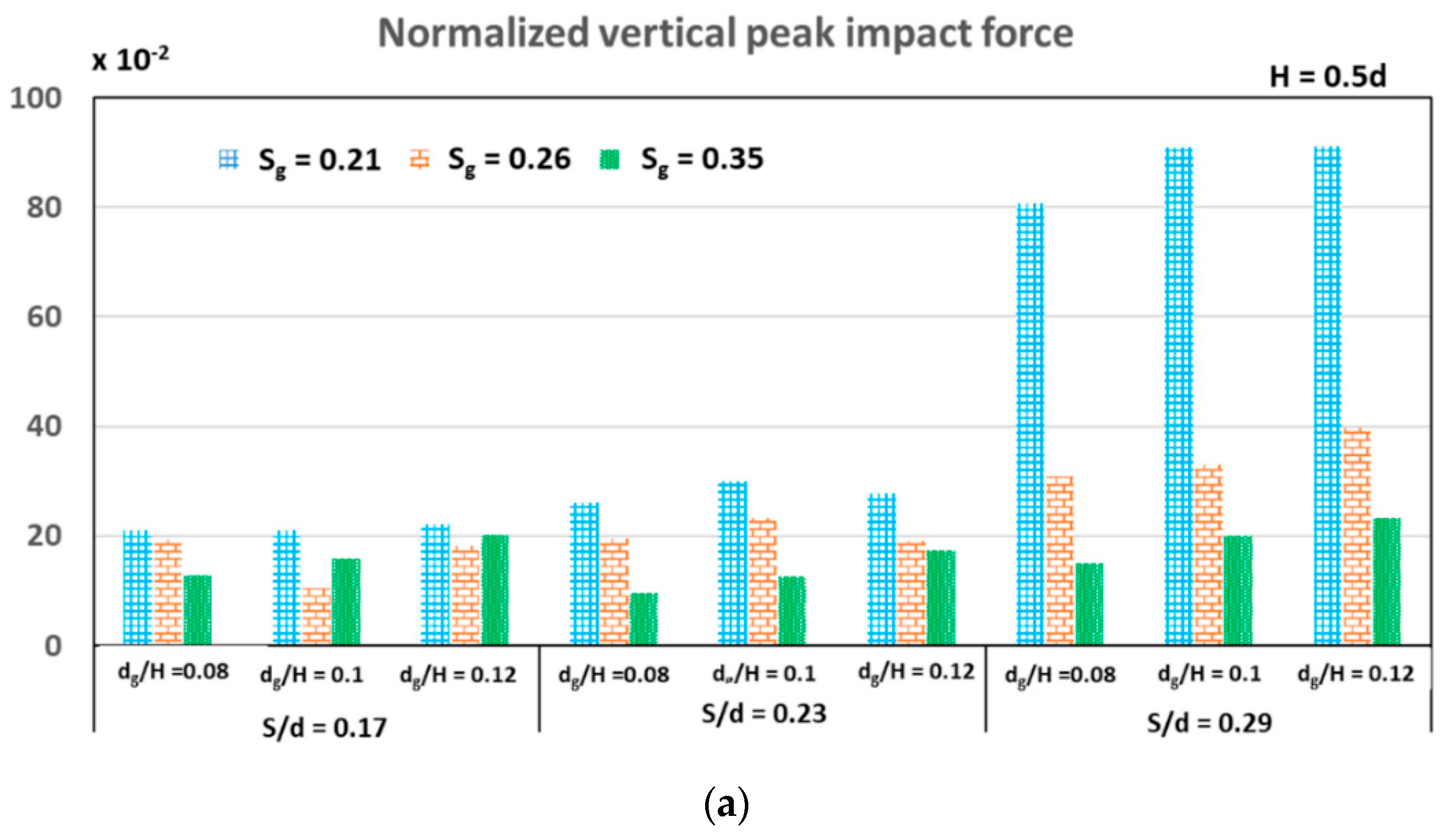

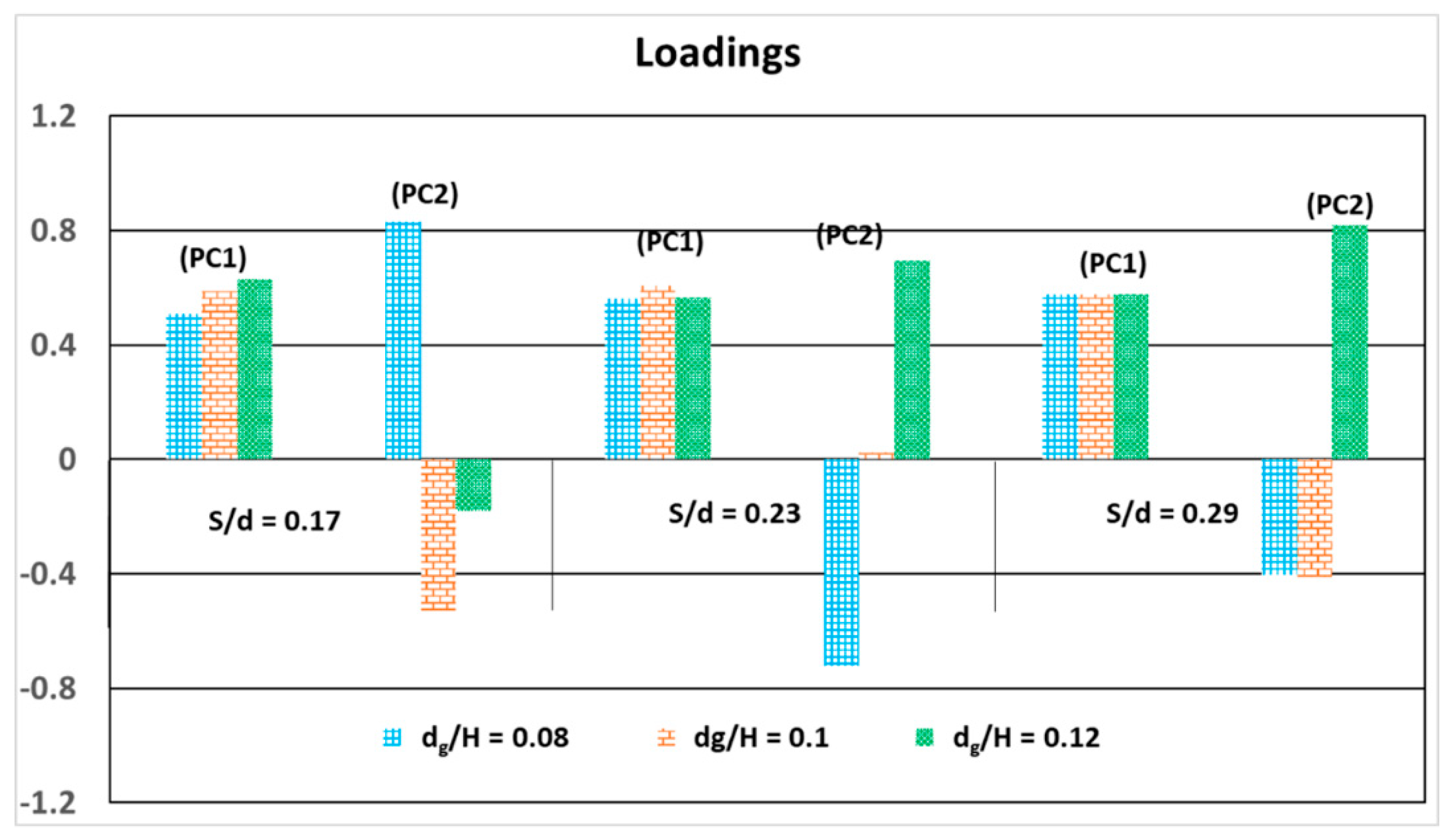

© 2019 by the authors. Licensee MDPI, Basel, Switzerland. This article is an open access article distributed under the terms and conditions of the Creative Commons Attribution (CC BY) license (http://creativecommons.org/licenses/by/4.0/).
Share and Cite
Moideen, R.; Ranjan Behera, M.; Kamath, A.; Bihs, H. Effect of Girder Spacing and Depth on the Solitary Wave Impact on Coastal Bridge Deck for Different Airgaps. J. Mar. Sci. Eng. 2019, 7, 140. https://doi.org/10.3390/jmse7050140
Moideen R, Ranjan Behera M, Kamath A, Bihs H. Effect of Girder Spacing and Depth on the Solitary Wave Impact on Coastal Bridge Deck for Different Airgaps. Journal of Marine Science and Engineering. 2019; 7(5):140. https://doi.org/10.3390/jmse7050140
Chicago/Turabian StyleMoideen, Rameeza, Manasa Ranjan Behera, Arun Kamath, and Hans Bihs. 2019. "Effect of Girder Spacing and Depth on the Solitary Wave Impact on Coastal Bridge Deck for Different Airgaps" Journal of Marine Science and Engineering 7, no. 5: 140. https://doi.org/10.3390/jmse7050140
APA StyleMoideen, R., Ranjan Behera, M., Kamath, A., & Bihs, H. (2019). Effect of Girder Spacing and Depth on the Solitary Wave Impact on Coastal Bridge Deck for Different Airgaps. Journal of Marine Science and Engineering, 7(5), 140. https://doi.org/10.3390/jmse7050140






